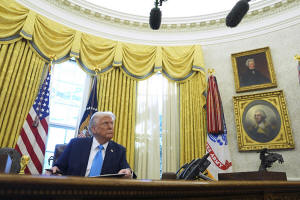In Trump's quest to close the Education Department, Congress and his own
agenda may get in the way
 Send a link to a friend
Send a link to a friend
 [February 05, 2025]
By COLLIN BINKLEY and BIANCA VÁZQUEZ TONESS [February 05, 2025]
By COLLIN BINKLEY and BIANCA VÁZQUEZ TONESS
WASHINGTON (AP) — President Donald Trump is preparing to gut the U.S.
Education Department to the full extent of his power, directing his
administration to slash spending while pressuring employees to quit. Yet
his promise to close the department is colliding with another reality:
Most of its spending — and its very existence — is ordered by Congress.
An executive order in preparation by the White House appears to
recognize the limits of the president’s power. The planned order would
direct his education chief to start winding down the agency but urge
Congress to pass a measure abolishing it, according to sources familiar
with the plan.
Trump has yet to sign such an order. But at a White House press
conference Tuesday, Trump quipped about the first task for Linda
McMahon, his nominee for education secretary.
“I want Linda to put herself out of a job,” Trump said.
Trump campaigned on a pledge to close the department, saying it has been
infiltrated by “radicals, zealots and Marxists.” In the nearly five
decades since the agency was created, conservatives have made occasional
attempts to shut it down, with critics saying it wastes taxpayer money
and inserts the federal government into local education decisions.
Trump is expected to give his education chief a deadline to deliver a
plan for the agency’s winddown. Yet even some of his allies question how
far he can go without Congress. Some of the department's most
significant programs are required by federal legislation, including
Title I money for low-income schools and federal student loans.

That was a source of frustration during Trump’s first term in office,
when his education chief repeatedly sought budget cuts but instead saw
Congress increase the agency’s spending each year.
What's more, Trump's quest to shut down the department could be
complicated by his own agenda. Already, he has created new work for the
department, including plans to promote “patriotic” education and efforts
to go after schools that teach controversial lessons on race and gender.
The agency also has opened new investigations into colleges, after Trump
ordered a crackdown on campus antisemitism.
What Trump can actually do to cut spending could be limited to tiny
fractions of the budget, according to one source with knowledge of the
plan. It would hardly dent the department’s $79 billion annual budget.
The sources spoke on the condition of anonymity because they weren’t
authorized to discuss the plan publicly.
Getting support from Congress would provide another test of Trump’s
sway. Some Republicans have raised doubts about the popularity of
closing the department or slashing its programs, which support
Republican and Democratic states alike.
The House considered amending a bill to close the agency in 2023, but 60
Republicans joined Democrats in opposing it. Last week Rep. Thomas
Massie, R-Kentucky, against introduced legislation to close the agency.
The one-sentence proposal said the Education Department “shall terminate
on December 31, 2026.”
Yet there are signs that Trump is determined to deliver his promise.
Dozens of Education Department employees were put on paid leave on
Friday in response to an executive order banning diversity, equity and
inclusion efforts in the federal government. Most of the workers don’t
work in DEI but had taken an optional diversity course promoted by the
department, according to a union that represents department staff.
Trump’s order called for government DEI officials to be fired to the
“maximum extent allowed by law.”
[to top of second column]
|

President Donald Trump speaks to reporters as he signs executive
orders in the Oval Office of the White House, Tuesday, Feb. 4, 2025,
in Washington. (AP Photo/Evan Vucci)

The White House has also pressured federal workers to quit.
Education Department workers were among those who received an offer
to leave their jobs by Feb. 6 and receive a buyout worth seven
months of salary.
A fresh wave of angst enveloped the agency when a team from Elon
Musk’s so-called Department of Government Efficiency showed up at
the department’s offices this week. An Education Department
spokesperson confirmed a team was on site Monday but did not provide
details on the nature of its work. Musk's colleagues have already
sought to close the U.S. Agency for International Development and to
gain access to sensitive payment systems at the Treasury Department.
Trump’s comments at his press conference raised alarms among schools
and states that rely on federal money. Federal funding makes up a
small portion of public school budgets — roughly 14% — but it adds
targeted support for low-income schools and special education, among
other grant programs.
In Minnesota, Democrats in the state assembly warned about the
potential impact of Trump’s order on Tuesday. Sen. Mary Kunesh said
she was worried the order could disrupt funding and called for more
clarity on the plan.
“Imagine if we have billions of dollars frozen at the federal
level," Kunesh said at a press conference. "How are we going to make
sure they have the curriculum they have to learn?”
Some Republicans in Minnesota's Legislature said there was no reason
to panic without full details of the order.
Those details are expected to be sorted out by Trump’s education
chief, and the president didn’t immediately say whether he would
look to preserve the department’s core work.
One potential model is found in Project 2025, a blueprint for
Trump’s second term created by the conservative Heritage Foundation.
The proposal calls for many of the department’s biggest programs to
be parceled out to other agencies.
Under the Project 2025 plan, Title I funding, the largest source of
federal money to public schools, would be moved to the Department of
Health and Human Services and given as block grants to states for
them to spend as they please, with no strings attached. The
Education Department’s Office for Civil Rights would shift to the
Justice Department.
Trump has sought distance from Project 2025, though he has hired
some of the staff behind it, and on some issues there’s considerable
overlap with his own platform.

Democrats in Congress were quick to jump on Trump’s plan. Sen.
Edward Markey, D-Mass., a member of the Health, Education, Labor,
and Pensions Committee, called it an “attack on educators, families
and students.” He vowed to fight it.
Trump’s plan could complicate the confirmation hearing for McMahon,
a billionaire professional wrestling mogul and longtime Trump ally.
Some advisers had asked the White House to keep the order quiet to
avoid thorny questions, and others are pushing for it to be signed
after her confirmation. No date has been set yet for her Senate
hearing.
___
Associated Press writer Steve Karnowski contributed from
Minneapolis.
All contents © copyright 2025 Associated Press. All rights reserved |